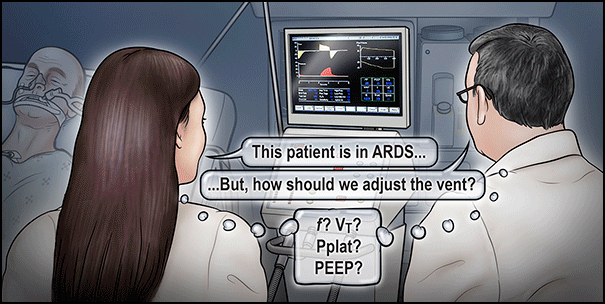In part four of the NEJM’s interactive case series we were asked to consider ventilation strategies for a 72 year old man with intraabdominal sepsis, hypoxic respiratory failure and bilateral diffuse pulmonary infiltrates.
The poll has now closed, and series editors Simon Finfer and Jean-Louis Vincent have provided their assessment of the evidence around ventilation in this context and introduced a terrific review article on the topic.

A 77-year-old man has been was admitted to the ICU following surgery for fecal peritonitis. The patient is 178 cm tall and weighs 60 kg. His arterial blood pressure has been supported with intravenous fluids and a norepinephrine infusion. After 24 hours in the ICU, he has a positive fluid balance of 2 liters.
Echocardiography shows normal left ventricular size and function, and a pulmonary-artery catheter shows that the pulmonary-artery occlusion pressure is 11 mm Hg. The patient is sedated and undergoing volume-cycled mechanical ventilation. Current ventilator settings are a tidal volume of 450 ml, a respiratory rate of 20 breaths per minute, a fraction of inspired oxygen (FiO2) of 0.6, and a positive end-expiratory pressure (PEEP) of 5 cm of water.CXR shows bilateral diffuse alveolar infiltrates, current arterial blood gases are pH 7.25, the partial pressure of arterial oxygen (PaO2) is 74 mm Hg (9.8 kPa), the partial pressure of arterial carbon dioxide (PaCO2) is 55 mm Hg (7.3 kPa), and the plateau airway pressure (at a time of zero tracheal airflow) is 32 cm of water.
The poll then asked what, if any, changes should be made to this man’s ventilation…
In brief, Professors Finfer and Vincent recommend the a ventilation strategy based on the seminal ARDS Network paper aiming for a tidal volume of 6ml/kg of predicted body weight (which in this case was 73 kg rather than 60kg) with “a slight decrease in tidal… to limit the plateau airway pressure to 30 cm of water and to increase the PEEP to 10 cm of water in view of the severity of the hypoxemic respiratory failure”.
The majority (65%) of respondents in the poll elected to do the same.
The editors note that of methods to recruit atelectatic lung (PEEP, recruitment manoeuvres, prone positioning etc), only prone positioning has a strong evidence base to support its use in centres where it can be conducted safely.
The Editors comments and the poll results in full can be found here.
Included with their recommendations is another excellent review, the fourth in this series, on the mechanism of Ventilator-Induced Lung Injury and the ventilation and adjunctive strategies to avoid it.
Look out for next instalment in this exciting case series appearing on the NEJM website soon.

























